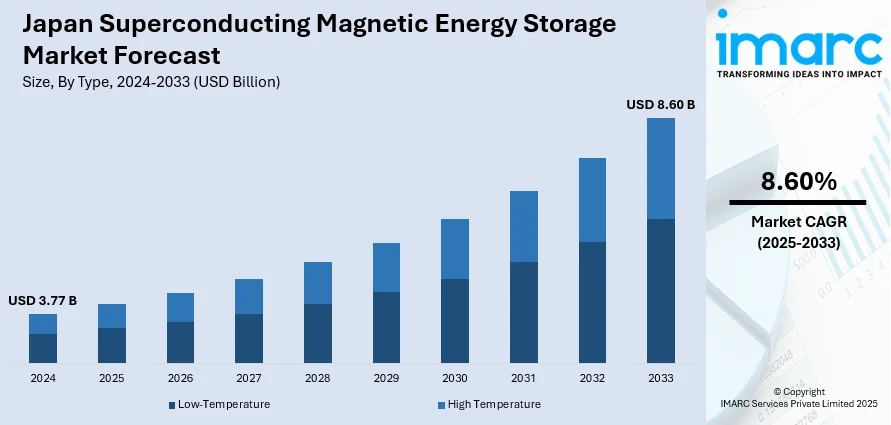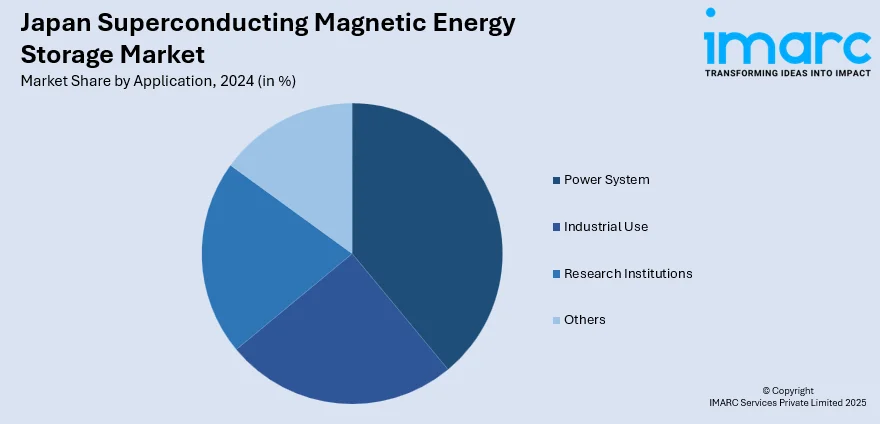
Japan Superconducting Magnetic Energy Storage Market Size, Share, Trends and Forecast by Type, Component, Application, and Region, 2025-2033
Japan Superconducting Magnetic Energy Storage Market Overview:
The Japan superconducting magnetic energy storage market size reached USD 3.77 Billion in 2024. Looking forward, IMARC Group expects the market to reach USD 8.60 Billion by 2033, exhibiting a growth rate (CAGR) of 8.60% during 2025-2033. Technological progress, domestic energy ambitions, and the push for carbon neutrality are driving the market. It is also supported by efforts to modernize the power grid, accessible urban land area constraints favoring high-density systems, and ultra-fast response energy storage requirements. Besides this, ongoing advancements in high-temperature superconducting (HTS) materials, falling costs of superconducting components, industrial demand for load balancing, supporting electric vehicle charging infrastructure, smart grid development schemes, and growing focus on domestic energy security and grid reliability are drivers pushing the Japan superconducting magnetic energy storage (SMES) market share.
|
Report Attribute
|
Key Statistics
|
|---|---|
|
Base Year
|
2024
|
|
Forecast Years
|
2025-2033
|
|
Historical Years
|
2019-2024
|
| Market Size in 2024 | USD 3.77 Billion |
| Market Forecast in 2033 | USD 8.60 Billion |
| Market Growth Rate 2025-2033 | 8.60% |
Japan Superconducting Magnetic Energy Storage Market Trends:
Renewable Energy Integration
Japan's swift move toward renewable sources of energy requires sophisticated storage systems to deal with the intermittency of sources such as wind and sunlight. Superconducting Magnetic Energy Storage (SMES) systems are now surfacing as a critical technology in this regard. SMES systems provide virtually instantaneous charging and discharging properties, which allow them to stabilize grid frequency and voltage fluctuations very well. Their high efficiency, with round-trip efficiencies in excess of 95%, makes them especially well-suited for smoothing the intermittent nature of renewable energy sources. In 2024, the commitment of Japan to incorporating renewable energy was highlighted by the government's move to invest in grid development and energy storage technologies. This move is to boost the reliability of the grid and allow for the smooth incorporation of renewable energy into the national grid. Implementation of SMES systems is an essential part of this strategy, which is aligned with Japan's overall objectives of becoming carbon neutral and ensuring energy security. The increasing focus on technological advancement, homegrown energy aspirations, and the rising penetration of renewables are driving the Japanese market for SMES. These systems not only help achieve carbon neutrality but also have a critical role to play in enhancing disaster-resilient infrastructure, making the country's energy future stable and sustainable.

Disaster-Resilient Grid Demand
Japan faces frequent natural disasters, including earthquakes, typhoons, and tsunamis, which threaten the stability of its power infrastructure. In early 2024, the Noto Peninsula experienced a magnitude 7.6 earthquake that left over 32,000 homes without power and caused widespread infrastructure damage. SMES systems are particularly suited for disaster-prone regions because they can deliver power almost instantly and resume operation quickly after disturbances. These systems store energy in a magnetic field, avoiding the chemical degradation seen in batteries, and can maintain performance through thousands of cycles. The Japanese government’s post-2011 infrastructure strategy includes funding for smart grids and local energy resilience, with SMES being tested in pilot projects to protect mission-critical operations like hospitals and emergency response centers. With limited tolerance for blackouts in urban and industrial zones, Japan continues to seek modular, high-reliability storage options that can withstand natural disruptions.
Government Decarbonization Targets
Japan has committed to achieving net-zero carbon emissions by 2050 and a 46% reduction in greenhouse gas emissions by 2030 relative to 2013 levels. Attempting to meet these goals, the Ministry of Economy, Trade and Industry (METI) has devised the "Green Growth Strategy" aimed at incentivizing next-generation energy technologies like SMES through subsidies and R&D incentives. One of the larger challenges of decarbonization is how to smooth a higher proportion of intermittent renewables without compromising grid stability. SMES can assist in this goal by offering brief support for peak loads and filling in the gaps during periods of low demand. Japan's energy strategy envisions a 50% proportion of non-fossil energy resources by 2050, with priority on smart grid and energy efficiency measures. Its potential to decrease transmission losses and enhance energy security, particularly in densely populated cities with high energy demand and limited backup options, also encourages the adoption of SMES.
Japan Superconducting Magnetic Energy Storage Market Segmentation:
IMARC Group provides an analysis of the key trends in each segment of the market, along with forecasts at the country and regional levels for 2025-2033. Our report has categorized the market based on type, component, and application.
Type Insights:
- Low-Temperature
- High Temperature
The report has provided a detailed breakup and analysis of the market based on the type. This includes low-temperature and high temperature.
Component Insights:
- Superconducting Coil
- Power Conditioning System (PCS)
- Cryogenics System
- Control and Monitoring System
A detailed breakup and analysis of the market based on the component have also been provided in the report. This includes superconducting coil, power conditioning system (PCS), cryogenics system, and control and monitoring system.
Application Insights:

- Power System
- Industrial Use
- Research Institutions
- Others
The report has provided a detailed breakup and analysis of the market based on the application. This includes power system, industrial use, research institutions, and others.
Regional Insights:
- Kanto Region
- Kansai/Kinki Region
- Central/Chubu Region
- Kyushu-Okinawa Region
- Tohoku Region
- Chugoku Region
- Hokkaido Region
- Shikoku Region
The report has also provided a comprehensive analysis of all the major regional markets, which include Kanto Region, Kansai/Kinki Region, Central/Chubu Region, Kyushu-Okinawa Region, Tohoku Region, Chugoku Region, Hokkaido Region, and Shikoku Region.
Competitive Landscape:
The market research report has also provided a comprehensive analysis of the competitive landscape. Competitive analysis such as market structure, key player positioning, top winning strategies, competitive dashboard, and company evaluation quadrant has been covered in the report. Also, detailed profiles of all major companies have been provided.
Japan Superconducting Magnetic Energy Storage Market News:
- In 2024, Chubu Electric Power Co., Inc. announced a project aimed at developing a next-generation superconducting coil. This initiative focuses on creating a device that is smaller, more cost-effective, and possesses a larger energy capacity compared to conventional metallic superconducting SMES systems.
Japan Superconducting Magnetic Energy Storage Market Report Coverage:
| Report Features | Details |
|---|---|
| Base Year of the Analysis | 2024 |
| Historical Period | 2019-2024 |
| Forecast Period | 2025-2033 |
| Units | Billion USD |
| Scope of the Report |
Exploration of Historical Trends and Market Outlook, Industry Catalysts and Challenges, Segment-Wise Historical and Future Market Assessment:
|
| Types Covered | Low-Temperature, High Temperature |
| Components Covered | Superconducting Coil, Power Conditioning System (PCS), Cryogenics System, Control and Monitoring System |
| Applications Covered | Power System, Industrial Use, Research Institutions, Others |
| Regions Covered | Kanto Region, Kansai/Kinki Region, Central/Chubu Region, Kyushu-Okinawa Region, Tohoku Region, Chugoku Region, Hokkaido Region, Shikoku Region |
| Customization Scope | 10% Free Customization |
| Post-Sale Analyst Support | 10-12 Weeks |
| Delivery Format | PDF and Excel through Email (We can also provide the editable version of the report in PPT/Word format on special request) |
Key Questions Answered in This Report:
- How has the Japan superconducting magnetic energy storage market performed so far and how will it perform in the coming years?
- What is the breakup of the Japan superconducting magnetic energy storage market on the basis of type?
- What is the breakup of the Japan superconducting magnetic energy storage market on the basis of component?
- What is the breakup of the Japan superconducting magnetic energy storage market on the basis of application?
- What is the breakup of the Japan superconducting magnetic energy storage market on the basis of region?
- What are the various stages in the value chain of the Japan superconducting magnetic energy storage market?
- What are the key driving factors and challenges in the Japan superconducting magnetic energy storage?
- What is the structure of the Japan superconducting magnetic energy storage market and who are the key players?
- What is the degree of competition in the Japan superconducting magnetic energy storage market?
Key Benefits for Stakeholders:
- IMARC’s industry report offers a comprehensive quantitative analysis of various market segments, historical and current market trends, market forecasts, and dynamics of the Japan superconducting magnetic energy storage market from 2019-2033.
- The research report provides the latest information on the market drivers, challenges, and opportunities in the Japan superconducting magnetic energy storage market.
- Porter's five forces analysis assist stakeholders in assessing the impact of new entrants, competitive rivalry, supplier power, buyer power, and the threat of substitution. It helps stakeholders to analyze the level of competition within the Japan superconducting magnetic energy storage industry and its attractiveness.
- Competitive landscape allows stakeholders to understand their competitive environment and provides an insight into the current positions of key players in the market.
Need more help?
- Speak to our experienced analysts for insights on the current market scenarios.
- Include additional segments and countries to customize the report as per your requirement.
- Gain an unparalleled competitive advantage in your domain by understanding how to utilize the report and positively impacting your operations and revenue.
- For further assistance, please connect with our analysts.
 Request Customization
Request Customization
 Speak to an Analyst
Speak to an Analyst
 Request Brochure
Request Brochure
 Inquire Before Buying
Inquire Before Buying




.webp)




.webp)












